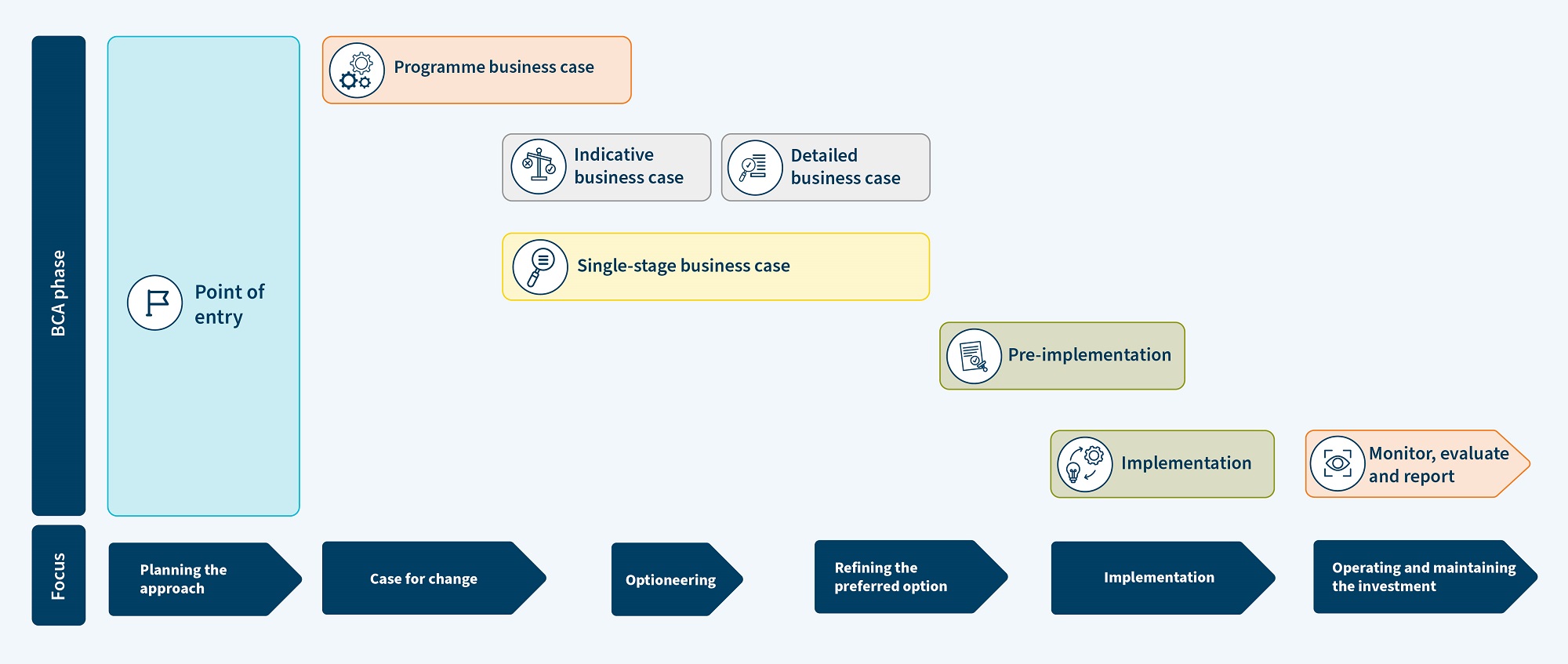![]() Learn more about the point of entry phase online
Learn more about the point of entry phase online
You can learn more about the point of entry phase through a dedicated interactive, online learning module. This module includes activities to help you understand the point of entry phase and set your business case off on the right foot.

This page introduces the point of entry (PoE) phase, the starting point of business case development. It explains why it is important, and how to have the conversations and gather the information you need and how to record it, and complete this phase.
If you are preparing to start the PoE phase, please talk to your investment advisor or email businesscaseprocess@nzta.govt.nz to get started.
The purpose of a PoE phase is to discuss and reach agreement on how the activity/potential investment should progress through the Business Case Approach (BCA). This includes:
The PoE phase ensures that business case work is well positioned. Double-up effort can be minimised by:
The PoE phase is meant to be a brief exercise using the minimum appropriate resource. The focus is on discussion and critical thinking to ensure fit-for-purpose effort and readiness to progress.
It is critical to record the outcome of a PoE phase, including any recommendations, so it can be clearly communicated to decision makers and stakeholders.
The BCA is aligned with the international Better Business Cases (BBC) and New Zealand Treasury BBC framework, and the PoE is equivalent to the BBC scoping document.
The diagram below shows where the PoE phase fits within the framework of business case development pathways.

View larger image [JPG, 218 KB]
Common reasons for starting a PoE include:
Formal endorsement of a PoE is required when applying for funding for the first phase of a business case from the National Land Transport Fund (NLTF).
For example, if the next phase after the PoE is a programme business case (PBC), and there is no previously endorsed PoE for this work, the funding request must be accompanied or preceded by a request to endorse the PoE.
There are also some situations where is it good practice to apply the discussion and critical thinking that a PoE uses, even when endorsement is not required:
In the PoE phase you will use discussions and critical thinking to explore the background to the investment and decide how best to develop a business case. The record of the point of entry (see below) is used to capture the outcome of these discussions.
Start talking with your NZ Transport Agency Waka Kotahi (NZTA) investment advisor at an early stage to get advice on how to carry out the PoE. If you don’t know who your investment advisor is, email businesscaseprocess@nzta.govt.nz
Effective engagement with stakeholders is a core part of any business case. For each phase of a business case you will need to think about the engagement required for that phase when scoping work and estimating costs.
This process of planning for effective engagement throughout a business case starts in the PoE. You have already spoken to your NZTA investment advisor – now think about who else you need to involve in your PoE conversation.
For example, you may also need to talk to one or more stakeholders to find out what they already know about the topic, and understand how they might expect or want to be involved. Think about colleagues and subject matter experts who may have established relationships or existing knowledge that will help you understand the investment.
Formal engagement planning is good practice, and there are a number of approaches available. For information on effective engagement planning, see our information sheet.
Point of entry: relationship management [PDF, 870 KB]
For more information on engagement in the BCA, see our detailed guidance.
Engagement and the Business Case Approach
When considering the potential investment, keep these tips in mind:
In the PoE phase you will need to apply the power skill of critical thinking and the BCA principles of investing for benefits, clarity of intent, fit-for-purpose effort, gathering information through informed discussions and building the case for investment progressively to develop your understanding about the potential investment.
Learning module about critical thinking in the Business Case Approach
Business Case Approach principles
Some key tools to assist with your PoE discussions include:
The PoE phase is about determining how the BCA is going to be applied, not doing the business case itself.
An agreed business case pathway allows project owners to have confidence in the scope required to reach the next investment decision gate, resources required (including funding), governance and other key aspects identified to address the risks, uncertainties, and complexities of the project.
In collaboration with a NZTA investment advisor, the PoE discussions and critical thinking will help determine the subsequent business case pathway of the activity.
If a business case is the next step, it is important to briefly consider the remaining phases through to implementation. This will provide decision makers with clarity regarding the forward pipeline of work.
The project approach may include information that has already been prepared by your organisation for your own internal purposes. The format is flexible, as long as there is the key information of how the project is going to be progressed.
The business case pathway needs to be demonstrative of the level of existing information, and the risk and complexity of the investment. Further advice on assessing risk and complexity, and finding the appropriate pathway for your business case, see our detailed guidance:
Your proposed business case pathway will be recorded in the ‘Project approach’ section of the record of PoE.
The PoE requirements for business cases about the potential replacement of existing structures are relatively consistent from case to case. Because of this, specific guidelines have been developed to help maintain consistency of practice and reduce the amount of effort needed to complete the PoE and plan the business case pathway.
The following guidelines include information on how the present value end-of-life (PVEOL) analysis should be used to support decision-making regarding existing structures.
Point of entry for structure replacement [PDF, 715 KB]
Bridge replacement at end-of-life [PDF, 160 KB]
The purpose of recording the PoE is to describe the problem/opportunity and likely outcomes of addressing it, and the expected scope required to complete the next phase. Having a documented record also means you can explain your thinking later on.
Before you complete the record of the PoE you will already have had the necessary conversations and explored your thinking, the relevant information you have or need and discussed options for applying the business case approach to the project, as detailed above.
We’ve developed the record of PoE template to help you capture the appropriate information.
Record of point of entry template [DOTX, 63 KB]
Remember to keep it brief – the record of the PoE is simply there to record the main points and findings of the PoE conversation. Focus on describing the gaps between ‘what is currently known’ and ‘what needs to be known’ about the investment, and how these will be addressed in the next phase.
The ‘Project approach’ section of the record of the PoE refers to how the BCA is going to be applied to the activity. This includes the business case pathway and the agreed scope that reflects how the identified risks, uncertainties and complexities are going to be addressed. This section also includes anticipated timeframes and resources required, such as NLTF investment. The project approach may include information that has already been prepared by your organisation for your own internal purposes. The format is flexible, as long as there is the key information of how the project is going to be progressed.
This will depend on how complex the investment is, and how much risk or uncertainty is involved.
You should work with your NZTA investment advisor throughout the PoE phase. They will be able to help you get the level of detail right and avoid missing any important information.
Before deciding whether your PoE is ready to submit for assessment, check in with your NZTA investment advisor.
When assessing applications to endorse a PoE, NZTA will seek assurance that the PoE has been adequately developed.
As a principles-based approach, there is no checklist of specific actions to follow to ensure that NZTA’s expectations regarding the PoE are being met. However, when assessing a PoE for endorsement there are some general questions that assessors will consider, to check that the relevant principles are being followed, including:
It is important to talk to us at an early stage of developing your business case. Contact your NZTA investment advisor or email the Business Case Process team at businesscaseprocess@nzta.govt.nz